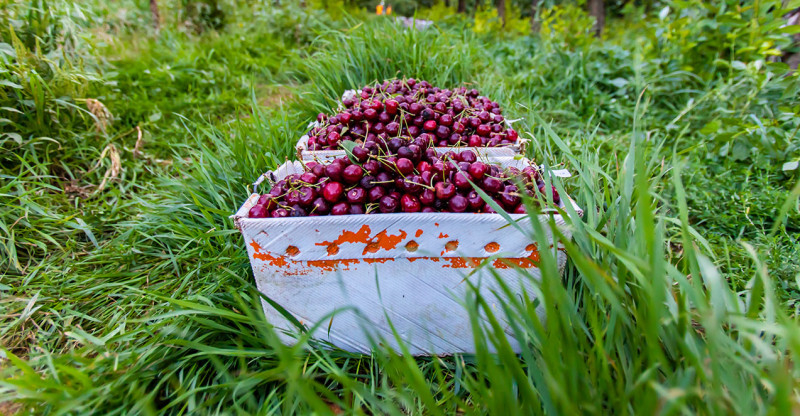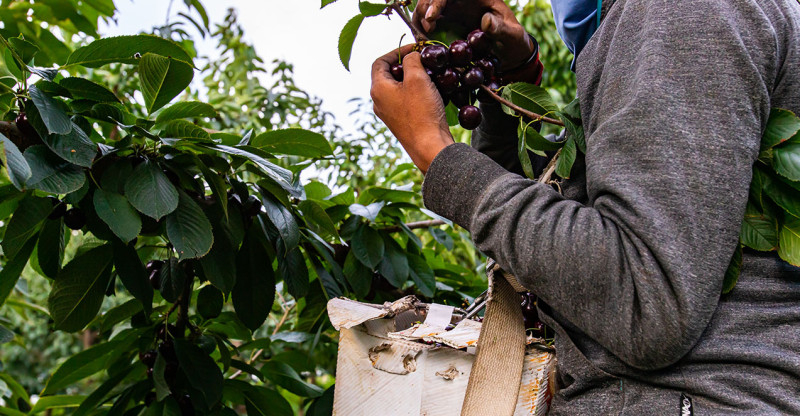Bowl(s) full of Cherries

LEGEND HAS IT that Lucullus, the ancient Roman general renowned for his extravagant feasts, met a tragic end when he reportedly took his own life after he realized he had eaten the last of his cherished supply of cherries. He simply couldn’t stomach the thought of a life without the sweet crimson fruits. Nearly 1,500 years later, King Charles V of France planted over 1,000 cherry trees in his gardens at St. Paul and Tournelle. While the details of these tales remain uncertain, one thing is clear: the allure of cherries has captivated hearts throughout history. Fast forward to the present day, and the enchantment surrounding these delectable fruits continues to flourish in the bountiful orchards of Washington state.
What is it about cherries that inspires such devotion? Perhaps it's the tender balance between their vibrant hues and their tantalizingly sweet flavors that ignites our senses. From the delicate blush of Rainier cherries to the rich crimson of Bing cherries, each bite delivers a burst of natural sweetness, evoking a symphony of sensations on the palate.
But it is not just their taste that sets cherries apart. Cherries symbolize nature's exquisite craftsmanship, nurtured by the fertile soil, abundant sunshine, and irrigation water sources that grace the landscapes of Washington state. Here, generations of skilled farmers have cultivated an art form, dedicating themselves to the delicate task of tending to these temperamental trees, carefully coaxing forth the fruits of their labor. And while cherries grow all over the state, two regions in particular have emerged as the largest producers: Yakima Valley and the Chelan area.
The first cherry trees arrived in the Pacific Northwest in 1847 on the back of a covered wagon. A pioneer named Henderson Lewelling loaded 700 fruit tree saplings in his wagon and made the journey over the Oregon Trail. When he arrived in the Portland area, he established a nursery of fruit trees, selling trees for $1.50 each to the never-ending stream of settlers. The Lewelling family was so prominent in the cherry tree trade that Henderson’s brother, Seth, is credited with developing the famous Bing cherry, named after his Manchurian foreman, Ah Bing.
Those trees made their way to the homesteads of Eastern Washington, and in the years since, they’ve grown from small saplings to a gigantic industry. More than 90% of the sweet cherries grown in America come from the Pacific Northwest and California, with Washington leading the way in total production. In 2021, Washington farmers produced 231,650 tons of cherries, with a value of $476 million. Sweet cherry orchards are most abundant in the Wenatchee and Yakima valleys, but can be found throughout Big Bend Country and throughout the Columbia Basin.
"It's fair to say that Eastern Washington is sort of a 'Goldilocks' climate for growing cherries," said B.J. Thurlby, president of the Washington State Fruit Commission. "And that perfect climate is really important because it's a fickle fruit to grow. Cherry growers are like the riverboat gamblers of the agricultural world, because a single cold night in March can devastate your season."
So with all that risk, why did cherries take off so strongly in the Evergreen State? Much of the success of cherry growers is due to the unique climate of Eastern Washington, where the winters are cold, the summer days are hot, and the summer nights are chilly. The sweet cherry tree must experience sufficient winter chilling in order to properly break dormancy and bloom over a relatively few days in the summer.
"The cold winters around here mean that we can’t grow 12 months out of the year, but they’re really important for tree fruit," said Thurlby. "It gives those trees enough chilling hours to rest over the course of the winter. We get into trouble in those years where it goes from 75 degrees to freezing within a week or two. The trees aren’t yet ready to go dormant, and so the buds are damaged, and trees are lost. Those kind of winters happen every 7-10 years. But the last few years, we’ve had some really nice, mild falls."
On top of that, the combination of hot summers with adequate irrigation is a huge factor. Cherry trees need a significant amount of water – around 42” of rainfall per season. But too much water triggers mildew and disease, so areas with unpredictable amounts of heavy rain are problematic. The ingenious irrigation techniques that bring water from rivers like the Columbia, the Yakima, and the Naches provide enough to keep the trees hydrated, but the Cascade "rain shadow" keeps them from getting too much unexpected moisture.
"Really, those two main growing areas are very similar in that aspect," said Thurlby. "The major difference between Yakima Valley and Chelan is just timing; the harvest in Chelan is about two weeks later. But even that works for our benefit. It means we can stretch out our 'peak season' for consumers buying cherries in the grocery store."


